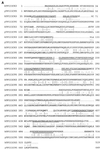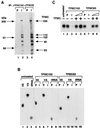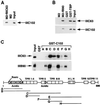Cloning and characterization of two evolutionarily conserved subunits (TFIIIC102 and TFIIIC63) of human TFIIIC and their involvement in functional interactions with TFIIIB and RNA polymerase III
- PMID: 10373544
- PMCID: PMC84305
- DOI: 10.1128/MCB.19.7.4944
Cloning and characterization of two evolutionarily conserved subunits (TFIIIC102 and TFIIIC63) of human TFIIIC and their involvement in functional interactions with TFIIIB and RNA polymerase III
Abstract
Human transcription factor IIIC (hTFIIIC) is a multisubunit complex that mediates transcription of class III genes through direct recognition of promoters (for tRNA and virus-associated RNA genes) or promoter-TFIIIA complexes (for the 5S RNA gene) and subsequent recruitment of TFIIIB and RNA polymerase III. We describe the cognate cDNA cloning and characterization of two subunits (hTFIIIC63 and hTFIIIC102) that are present within a DNA-binding subcomplex (TFIIIC2) of TFIIIC and are related in structure and function to two yeast TFIIIC subunits (yTFIIIC95 and yTFIIIC131) previously shown to interact, respectively, with the promoter (A box) and with a subunit of yeast TFIIIB. hTFIIIC63 and hTFIIIC102 show parallel in vitro interactions with the homologous human TFIIIB and RNA polymerase III components, as well as additional interactions that may facilitate both TFIIIB and RNA polymerase III recruitment. These include novel interactions of hTFIIIC63 with hTFIIIC102, with hTFIIIB90, and with hRPC62, in addition to the hTFIIIC102-hTFIIIB90 and hTFIIIB90-hRPC39 interactions that parallel the previously described interactions in yeast. As reported for yTFIIIC131, hTFIIIC102 contains acidic and basic regions, tetratricopeptide repeats (TPRs), and a helix-loop-helix domain, and mutagenesis studies have implicated the TPRs in interactions both with hTFIIIC63 and with hTFIIIB90. These observations further document conservation from yeast to human of the structure and function of the RNA polymerase III transcription machinery, but in addition, they provide new insights into the function of hTFIIIC and suggest direct involvement in recruitment of both TFIIIB and RNA polymerase III.
Figures











Similar articles
-
The TFIIIC90 subunit of TFIIIC interacts with multiple components of the RNA polymerase III machinery and contains a histone-specific acetyltransferase activity.Mol Cell Biol. 1999 Nov;19(11):7697-704. doi: 10.1128/MCB.19.11.7697. Mol Cell Biol. 1999. PMID: 10523658 Free PMC article.
-
Identical components of yeast transcription factor IIIB are required and sufficient for transcription of TATA box-containing and TATA-less genes.Mol Cell Biol. 1994 Apr;14(4):2798-808. doi: 10.1128/mcb.14.4.2798-2808.1994. Mol Cell Biol. 1994. PMID: 8139577 Free PMC article.
-
TFIIIC-independent in vitro transcription of yeast tRNA genes.J Mol Biol. 2000 Jun 9;299(3):601-13. doi: 10.1006/jmbi.2000.3783. J Mol Biol. 2000. PMID: 10835271
-
Comparison of the RNA polymerase III transcription machinery in Schizosaccharomyces pombe, Saccharomyces cerevisiae and human.Nucleic Acids Res. 2001 Jul 1;29(13):2675-90. doi: 10.1093/nar/29.13.2675. Nucleic Acids Res. 2001. PMID: 11433012 Free PMC article. Review.
-
Regulation of tRNA synthesis by the general transcription factors of RNA polymerase III - TFIIIB and TFIIIC, and by the MAF1 protein.Biochim Biophys Acta Gene Regul Mech. 2018 Apr;1861(4):320-329. doi: 10.1016/j.bbagrm.2018.01.011. Epub 2018 Feb 6. Biochim Biophys Acta Gene Regul Mech. 2018. PMID: 29378333 Review.
Cited by
-
K562 cells implicate increased chromatin accessibility in Alu transcriptional activation.Nucleic Acids Res. 2000 Aug 15;28(16):3031-9. doi: 10.1093/nar/28.16.3031. Nucleic Acids Res. 2000. PMID: 10931917 Free PMC article.
-
Participation of TFIIIB Subunit Brf1 in Transcription Regulation in the Human Pathogen Leishmania major.Genes (Basel). 2021 Feb 16;12(2):280. doi: 10.3390/genes12020280. Genes (Basel). 2021. PMID: 33669344 Free PMC article.
-
Widespread use of TATA elements in the core promoters for RNA polymerases III, II, and I in fission yeast.Mol Cell Biol. 2001 Oct;21(20):6870-81. doi: 10.1128/MCB.21.20.6870-6881.2001. Mol Cell Biol. 2001. PMID: 11564871 Free PMC article.
-
Evidence of RNA polymerase III recruitment and transcription at protein-coding gene promoters.bioRxiv [Preprint]. 2024 Jun 9:2024.06.08.598009. doi: 10.1101/2024.06.08.598009. bioRxiv. 2024. Update in: Mol Cell. 2024 Nov 7;84(21):4111-4124.e5. doi: 10.1016/j.molcel.2024.09.019. PMID: 38895345 Free PMC article. Updated. Preprint.
-
Biallelic variants in GTF3C5, a regulator of RNA polymerase III-mediated transcription, cause a multisystem developmental disorder.Hum Genet. 2024 Mar;143(3):437-453. doi: 10.1007/s00439-024-02656-3. Epub 2024 Mar 23. Hum Genet. 2024. PMID: 38520561
References
-
- Bieker J J, Martin P L, Roeder R G. Formation of a rate-limiting intermediate in 5S RNA gene transcription. Cell. 1985;40:119–127. - PubMed
Publication types
MeSH terms
Substances
Associated data
- Actions
- Actions
Grants and funding
LinkOut - more resources
Full Text Sources
Other Literature Sources
Molecular Biology Databases
Research Materials
